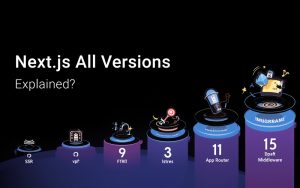
Next.js is a powerful front-end web development framework built on top of React, the popular JavaScript library used for creating user interfaces. It helps developers build modern, fast, and user-friendly websites and web applications more efficiently. One of the biggest advantages of Next.js is that it offers built-in support for server-side rendering (SSR), which means pages can be generated on the server before being sent to the user’s browser. This improves website speed, performance, and search engine rankings.
Another great feature of Next.js is static site generation (SSG), which allows web pages to be pre-built and served instantly. This makes websites load faster and reduces server load. Next.js also supports incremental static regeneration (ISR), a smart technology that updates only the necessary parts of a site without rebuilding the whole thing, combining the benefits of both static and dynamic content.
In addition, Next.js automatically handles routing, supports image optimization, and is easy to integrate with headless CMS platforms like Sanity. These features make it a popular choice among developers and companies looking to create high-performance websites that are scalable, SEO-friendly, and easy to manage.
What are the core features of Next.js?

Next.js is a powerful React framework that helps developers build fast, user-friendly websites and web applications. Here are the core features that make Next.js stand out:
- Server-Side Rendering (SSR):
Next.js allows you to render web pages on the server at the time of each request. This improves website speed, SEO, and performance, especially for dynamic content. - Static Site Generation (SSG):
You can also generate HTML pages at build time, which means the content is ready to serve instantly. This makes your website faster and more efficient. - Hybrid Rendering:
One of the biggest strengths of Next.js is that you can use both SSR and SSG in the same project—choosing the best method for each page. - Automatic Code Splitting:
Next.js only loads the JavaScript and CSS needed for the current page. This reduces loading time and makes your app feel faster to users. - API Routes:
You can create backend APIs directly within your Next.js app. This removes the need for a separate backend server for basic functionality. - Built-in Routing System:
Next.js uses a file-based routing system, which means the file structure of your project automatically defines the website’s routes. No extra configuration is needed. - Optimized Image Handling:
Next.js includes an image component that automatically optimizes images for different devices and screen sizes, improving page load speed. - Fast Refresh and Developer Experience:
It offers real-time updates during development. Changes appear instantly in the browser without losing the app’s state, making development faster and smoother. - SEO-Friendly Architecture:
With features like SSR, SSG, and customizable meta tags, Next.js helps websites rank better on search engines like Google. - Strong Integration with Headless CMSs (e.g., Sanity, Contentful):
Next.js works great with content management systems, allowing developers to build dynamic websites powered by structured content. - Performance Optimization:
Next.js includes built-in performance tools like image optimization, script loading, and analytics, helping your site run smoothly and load quickly. - Support for TypeScript and Rust-based Tooling:
It offers native support for TypeScript and uses fast Rust-based tools for building and bundling, ensuring high performance.
How does Next.js compare to other frameworks?

Next.js stands out from other JavaScript frameworks because it combines the flexibility of React with powerful built-in features that save time and improve performance. While many frameworks focus only on building user interfaces, Next.js offers a full toolkit for creating modern web applications.
One major advantage of Next.js is server-side rendering (SSR) and static site generation (SSG), which help websites load faster and rank better on search engines. Unlike some frameworks that rely only on client-side rendering (which can be slower and less
SEO-friendly), Next.js delivers content more efficiently and improves the user experience.
Another benefit is that Next.js requires less setup. With other frameworks, developers often have to spend time adding tools for routing, API handling, and performance optimization. Next.js includes all of this out of the box, making development faster and easier.
In summary, Next.js is a powerful and beginner-friendly framework that offers better speed, SEO, and productivity compared to many others. It’s a smart choice for building fast, scalable, and search-friendly websites.
What are the most common use cases for Next.js?

Next.js is a powerful React-based framework used by developers to build fast, SEO-friendly websites and web apps. Here are the most common use cases:
E-commerce Websites
Next.js helps online stores load faster and perform better on search engines. Its ability to support server-side rendering makes product pages quick and SEO-optimized, which is great for attracting more traffic and increasing sales.
Blogs and Content Websites
With features like static site generation (SSG), Next.js is perfect for blogs, personal websites, and content-heavy platforms. It allows for fast loading times and easy content updates.
Marketing and Landing Pages
Next.js is widely used for building high-converting marketing websites and landing pages. Its performance and SEO features help businesses attract and retain more visitors.
News and Media Platforms
For websites that publish frequent updates—like news sites or media blogs—Next.js makes it easy to manage and display real-time content while maintaining speed and performance.
Documentation Sites
Companies use Next.js to build technical documentation websites because it offers fast navigation, clean layouts, and excellent performance—even with lots of content.
Web Applications (Dashboards, Portals, etc.)
Next.js supports dynamic content, user authentication, and real-time data—making it a good choice for building dashboards, admin panels, and custom web tools.
Community and Social Platforms
Web apps with user-generated content, like forums or communities, benefit from Next.js’s fast load times and scalable structure.
Booking and Event Websites
From travel booking sites to event platforms, Next.js allows developers to create interactive, user-friendly experiences that handle large volumes of data smoothly.
Portfolio Websites
Freelancers and creators use Next.js to build professional, fast-loading portfolio websites that look great and rank well on Google.
Bonus Tip: When combined with a headless CMS like Sanity, Next.js makes content management super simple for any website type.
Next.js All Versions Explained?

Next.js is a popular React framework that makes building fast and SEO-friendly websites easier. Over time, Next.js has released many versions, each bringing new features and improvements. Here’s a simple and to-the-point explanation of all major Next.js versions.
1. Next.js 1 to 4 (Early Days)
These early versions focused on basic server-side rendering with React. They allowed developers to build simple pages using file-based routing. However, there were limited features compared to what we see today.
2. Next.js 5 (Introduced Plugins & Custom Server)
Next.js 5 introduced features like custom server support and plugins. This allowed more flexibility and better control for developers.
3. Next.js 6 to 8 (Better Performance & Static Exports)
These versions improved performance, error handling, and introduced the ability to export static HTML files. This helped websites load faster and improved SEO.
4. Next.js 9 (API Routes & Dynamic Routing)
A major update! Next.js 9 added:
-
- API routes: You could now create backend APIs inside your app.
- Dynamic routing: URLs could now include variables (like /blog/[id]).
These features made Next.js great for full-stack apps.
5. Next.js 10 (Image Optimization & i18n Support)
This version focused on performance and user experience:
- Image component for automatic image optimization
- Internationalization (i18n) for multi-language support
- Improved static site generation (SSG)
6. Next.js 11 (Conformance & Fast Refresh)
Version 11 focused on developer experience:
- Conformance checks: Helped write better code
- Improved Fast Refresh: Quicker updates during development
7. Next.js 12 (Middleware & Rust Compiler)
A powerful update with:
- Middleware: Run code before rendering a page (e.g., auth checks)
- Rust-based compiler: Made builds and refreshes much faster
- ES Modules support
8. Next.js 13 (App Router & New File Structure)
This version changed how apps are built:
- App Router: A new way to build layouts and pages
- React Server Components: Better performance and smaller bundles
- Loading UI and improved caching
It was a big step towards modern web development.
9. Next.js 14 (Improved Stability & Partial Prerendering)
Next.js 14 continued to improve the App Router:
- Partial Prerendering: Mix static and dynamic content on one page
- Faster rendering and better developer tools
- Focus on performance and stability
Which version of Next.js is used in today?

As of 2025, the latest and most commonly used version of Next.js is Next.js 14.
Next.js 14 is widely adopted by developers because it offers:
- Improved App Router for better page and layout management
- Partial Prerendering, which mixes static and dynamic content on the same page
Faster performance and smaller page sizes - Better developer experience with new tools and stability updates
Although some older projects may still use previous versions like Next.js 13 or 12, Next.js 14 is the recommended version for new projects because it’s stable, fast, and includes the latest features.
Conclusion:
Next.js is one of the best tools available today for building fast, SEO-friendly, and scalable websites. Whether you’re creating a blog, an e-commerce store, a dashboard, or a portfolio, Next.js offers everything you need—right out of the box.
With powerful features like Server-Side Rendering (SSR), Static Site Generation (SSG), API routes, image optimization, and support for modern tools like TypeScript and Rust-based compilers, it’s perfect for both beginners and professionals.
What makes Next.js even better is its ability to handle both static and dynamic content, making websites faster, more reliable, and user-friendly. And with constant updates (like the latest Next.js 14), it stays up to date with the latest web development trends.
FAQ
- What is Next.js?
Next.js is a React-based web development framework that helps you build fast, SEO-friendly websites and web apps. It comes with built-in features like server-side rendering (SSR), static site generation (SSG), and automatic routing, which make development easier and your site faster. It’s widely used by developers to create everything from personal blogs to large e-commerce platforms.
- What is the difference between Next.js and React?
React is a JavaScript library for building user interfaces. Next.js is a framework built on top of React that adds features like routing, server-side rendering, and static site generation to make development faster and easier.
- Can we use Next.js to build a blog or e-commerce website?
Absolutely! Next.js is perfect for blogs, e-commerce websites, landing pages, and more. It helps improve site speed and SEO, which is especially important for content-heavy or product-based websites.

